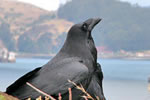Description |
The massive California Condor is one of America’s largest and rarest birds. The adult is mostly black with large white wing patches and a featherless head. The color of the head can vary from white, to pink, to orange, depending on the condor’s emotional state. The male condor has a tuft of black feathers extending from the base of the neck. The condor’s wingspan can exceed nine feet and the average adult weighs in excess of 20 pounds. |
| |
Diet |
| The California Condor eats carrion. It actually has no sense of smell, and finds dead animals by observing the movements of vultures and eagles. They prefer to eat large mammals such as deer, goats, horses, sheep, and even bears. The huge condor dominates other birds at carcasses, except the Golden Eagle. Condors in the wild go days or weeks without eating before gorging themselves on several pounds of dead animal. |
| |
Range/Habitat |
| The California Condor once roamed the entire American southwest from Texas to California and into parts of northern Mexico. Today, it is restricted to designated habitats in Arizona and southern California. California Condors prefer dry, mountains habitats with large trees and scrub growth. |
| |
Reproduction |
| The California Condor’s notoriously slow rate of reproduction has undoubtedly contributed to its population decline. Females become reproductively mature at age six, and choose a mate for life. The simple nest is built in a cave or upon a cliff and the female lays one or two eggs every other February or March. After about eight weeks, the eggs hatch. The young condor(s) can fly after about six months. |
| |
Status |
| The California Condor is one of America’s most critically endangered animals. Today, there are about 300 individuals in existence, which is actually a significant improvement over the 22 individuals that were confirmed in existence in 1987. All 22 of those birds were captured and cared for in captivity that year for the purpose of saving the species from certain extinction. Although the condor was never common, populations of condors plummeted because of habitat destruction, pesticides, lead shot (which would contaminate carcasses), and electrical towers (which the birds would collide with). In a landmark effort, biologists from the San Diego Zoo initiated a captive breeding program with the condors and successfully increased their numbers to the point where some individuals could be re-released into the wild. Scientists took advantage of the condor’s tendency to double clutch, or, lay another egg if the first is lost or destroyed. Newly released Condors have been trained to avoid electrical towers and people. In 2003, the first young condor fledged in the wild since 1981. Furthermore, a female Condor recently laid an egg in Mexico, marking the first time a condor has nested in Mexico since the 1930’s. |
|














